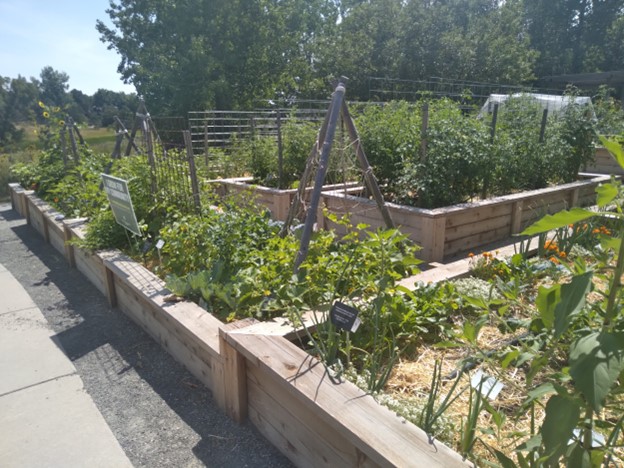Sporting a New Look at Silo
- 2023-09-04
- By mkirk
- Posted in Horticulture, The Garden Buzz
By Judy Kunz, Colorado Master Gardener

Since partnering with the city of Greenwood Village in 2012, Arapahoe County Master Gardeners have planned, maintained and harvested more than 13,000 pounds of produce at Silo Park, donating it to those in need through the Covenant Cupboard Food Pantry. However, after 11 plus years of use, the basic garden structures were deteriorating, and, as a result, the city constructed new beds last spring, adding new soil specially mixed for the garden.
The garden is back in operation this season and thriving in spite of two heavy spring hail storms that did considerable damage and almost wiped out many of the young seedlings. Particularly vulnerable tomatoes and eggplant were replanted and many of the other plants that sustained minor damage are still in the process of catching up, just in time for harvest.
The gardens at Silo have proven superior through the years for maximum yield. The generous harvest has been possible, in large part, because of the raised bed design that is preferable to traditional in-ground row planting.

Some advantages of raised bed gardens are:
- Soil warms up earlier in spring, allowing it to be worked and planted sooner than traditional in-ground gardens, extending the growing season.
- Plants are easier to maintain because gardeners can sit or kneel at the perimeter and reach into the beds to weed and harvest.
- Closed row or block style planting yields more harvest than traditional garden rows because plants can be arranged more densely. Additionally, no space is needed for walking paths.
- The soil is easier to work. There is decreased soil compaction and more oxygen available to plant roots because of limited foot traffic, thereby increasing yield.
- Fewer weeds germinate because plants are closer together, shading out weed seeds.
- It is easier to cover raised beds with hoops for insect and shade control.
A raised bed garden is easy to construct by making a simple frame with untreated lumber, or prefabricated frames can be purchased from most big box stores. The soil needs to be only several inches above the surrounding soil to have the advantages of a raised bed.
Things to remember when planning a raised bed garden:
- Build beds that are no more than four feet in width for ease in maintenance from each side. They can be any length suitable for the space.
- If native soil is used, spade in several inches of organic matter each year. Plants in raised beds thrive on rich, weed-free soil.
- If purchased soil is used, spade some of it into the native soil to prevent soil interface problems that may interfere with water percolation.
- Avoid purchased soil that contains wood products such as bark chips. They tie up the nutrients in the soil as they break down.
- Because of denser block-style placement, plants may need to be watered more frequently.
- Mulch plants with grass clippings or bark mulch to keep roots cool and minimize evaporation.
Next season consider installing a raised bed garden and “raise”your harvest!
More details on raised bed gardening:
Horticulture Resources
- Garden Buzz Archives
- CSU Extension Resources
- Colorado Master Gardener Program
- Foothills to Plains Native Plant Master Program
- Native Bee Watch Community Science Program
- The Co-Hort Blog
- PlantTalk Colorado
- Soil Testing
- Plant Select
- Emerald Ash Borer
- Japanese Beetle
- Colorado State Forest Service
- Ask an Expert


